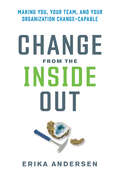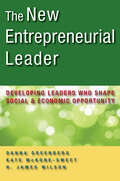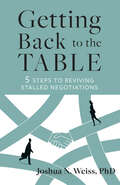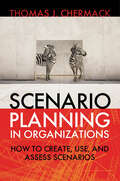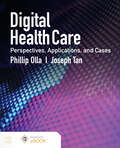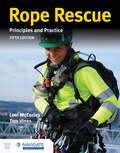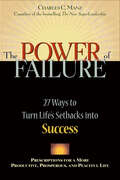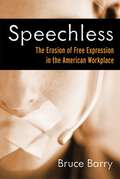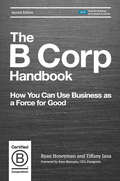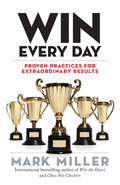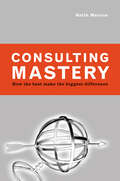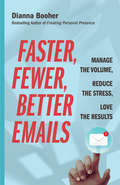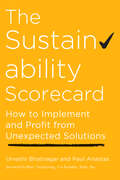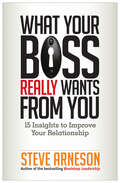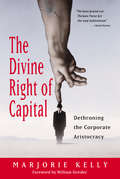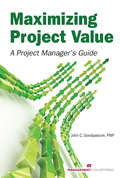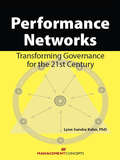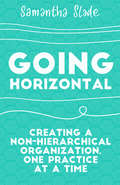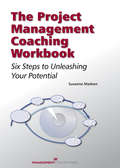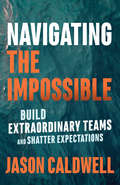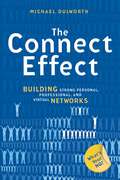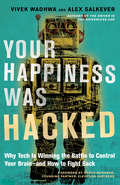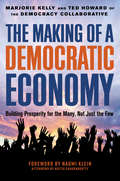- Table View
- List View
Change from the Inside Out: Making You, Your Team, and Your Organization Change-Capable
by Erika AndersenChange initiatives fail because humans are hardwired to return to what's worked for us in the past. This book offers a straightforward process for rewiring ourselves and those we lead to be more change-capable. Erika Andersen says avoiding change has been a historical imperative. In this book, she shows how we can overcome that reluctance and get good at making necessary change. Using a fictional story about a jewelry business changing generational hands, Andersen lays out a five-step model for addressing both this human side of change and its practical aspects: Step 1: Clarify the change and why it's needed—Get clear on what the change is and the benefits it will bring.Step 2: Envision the future state—Build a shared picture of the post-change future.Step 3: Build the change—Bring together a change team, engage key stakeholders, and plan the change.Step 4: Lead the transition—Build a transition plan that supports the human side of the change, then engage the whole organization in making the change.Step 5: Keep the change going—Work to make your organization permanently more change-capable. With opportunities to self-reflect and try out the ideas and approaches throughout, this book is a practical guide to thriving in this era of nonstop change.
The New Entrepreneurial Leader: Developing Leaders Who Shape Social and Economic Opportunity
by H. James Wilson Danna Greenberg Kate McKone-SweetIn years past, the keywords for leaders were confidence, single-minded purpose, and strategic planning. But today’s vastly complex, globalized, and fast-evolving world requires a different kind of leadership. This game-changing book details a new approach—entrepreneurial leadership—developed at Babson College, the number-one school for entrepreneurship in the world. Entrepreneurial leadership is inspired by, but is separate from, entrepreneurship. It can be applied in any organizational situation, not just start-ups. Based on two years of extensive research, it embraces three principles that add up to a fundamentally new worldview of business and a new logic of decision making. First, rapid change and increasing uncertainty require leaders to be “cognitively ambidextrous,” able to shift between traditional “prediction logic” (choosing actions based on analysis) and “creation logic” (taking action despite considerable unknowns). Guiding this different way of thinking and acting is a new view of business, where simultaneous creation of social, environmental, and economic value is the order of the day. Finally, entrepreneurial leaders leverage their understanding of themselves and their social context to guide effective action. Each chapter offers concrete examples of how educators across all disciplines are integrating these ideas into their courses—and even their entire curricula. The New Entrepreneurial Leader lays out a comprehensive new paradigm for reinventing management education in order to mold leaders who will shape social and economic opportunity.
Hello Stay Interviews, Goodbye Talent Loss: A Manager's Playbook
by Sharon Jordan-Evans Beverly KayeStay interviews prevent exit interviews! You can't afford to lose them. They're your stars and your solid citizens. You wonder if they're happy in your organization—and what might keep them there. To find out, you could:A. Conduct a survey—then try to guess who said what.B. Take note of their latest tattoos. Is your company logo among them?C. Ask, "What will keep you here?"The correct answer is C. It's the opening line of a great stay interview, and it could make the difference between keeping and losing your best people. Worried that your talented people will want things you can't deliver, like more money or a big promotion? Beverly Kaye and Sharon Jordan-Evans have a simple four-step process for dealing with that. Not sure how to get started? They provide dozens of suggested questions and icebreakers. Think you don't have time? They offer all kinds of creative time-saving options for where, when, and how you can do stay interviews.
Getting Back to the Table: 5 Steps to Reviving Stalled Negotiations
by Joshua N. WeissThe co-founder of Harvard's Global Negotiation Initiative and a renowned global guru in negotiations, presents a dynamic strategy for overcoming stalled or failed negotiations that empowers individuals to return to the table with increased strength and resilience, carefully learning from the challenges they encountered. When negotiations fail it can be hard to start over. Some people give up, others forget and move on, but the truly successful negotiator learns. Celebrated negotiation thought-leader and member of the UN Negotiations team, Joshua N. Weiss, introduces an evidence-based model for when negotiations stall or fail. Getting Back to the Table explores the reality of failure in negotiation. It lays out the types of failure that can happen, how to cope with it when it does, and how we can be resilient in the face of it. Using Weiss’s easy-to-use framework, readers can successfully get back to the negotiation table. Failing in negotiations is inevitable, but learning and growing from failure is not.
Scenario Planning in Organizations: How to Create, Use, and Assess Scenarios
by Thomas J. ChermackScenario planning helps organization leaders, executives and decision-makers envision and develop strategies for multiple possible futures instead of just one. It enables organizations to become resilient and agile, carefully calibrating their responses and adapting quickly to new circumstances in a fast-changing environment. This book is the most comprehensive treatment to date of the scenario planning process. Unlike existing books it offers a thorough discussion of the evolution and theoretical foundations of scenario planning, examining its connections to learning theory, decision-making theory, mental model theory and more. Chermack emphasizes that scenario planning is far more than a simple set of steps to follow, as so many other practice-focused books do—he addresses the subtleties and complexities of planning. And, unique among scenario planning books, he deals not just with developing different scenarios but also with applying scenarios once they have been constructed, and assessing the impact of the scenario project. Using a case study based on a real scenario project Chermack lays out a comprehensive five phase scenario planning system—project preparation, scenario exploration, scenario development, scenario implementation and project assessment. Each chapter describes specific techniques for gathering and analyzing relevant data with a particular emphasis on the use of workshops to encourage dialogue. He offers a scenario project worksheet to help readers structure and manage scenario projects as well as avoid common pitfalls, and a discussion, based in recent neurological findings, of how scenario planning helps people to overcome barriers to creative thinking. “This book is about action and performance. Compelling and thoroughly researched, it offers every business executive a playbook for including uncertainty in the organizational change process and driving competitive advantage”. -- Tim Reynolds, Vice President, Talent and Organization Effectiveness, Whirlpool Corporation
Digital Health Care: Perspectives, Applications, and Cases
by Joseph Tan Phillip OllaDigital Health Care: Perspectives, Applications, and Cases explores the trends, perspectives, and cases of Digital Healthcare and Informatics (DHI) that are transforming healthcare across the globe.Organized in 5 major connecting parts, this well-conceived text begins by laying out foundational DHI themes before focusing in on key DHI core technologies, developments, methods and challenges - from big data analytics & artificial intelligence to security and privacy issues, clinical decision support systems, consumer health informatics, and more. It then explores DHI emerging technologies (e.g. sensors and wearable electronics), and concludes with short case studies and critical case questions designed to reinforce conceptual understanding.Written for undergraduates health professionals, this accessible text offers a multidisciplinary perspective that is suitable for use in variety of healthcare disciplines-from allied health and nursing to health administration, public health, and health informatics. Each chapter follows a consistent structure that comprehensively covers a specific DHI topic(s) and related key technological components along with workplace practices from a multidisciplinary perspective.Real world cases studies (in Part 5) help students understand key and illustrate how they can been applied in real-world settings.Clinical innovations and techniques for evaluating clinical outcomes, such as improved care, performance improvement, and cost reduction in clinical settings, are explored and emphasized throughout the text.Technology and issues that a transforming the health care industry are explored including standardization, artificial intelligence (AI), cloud computing, medical sensors, enterprise architectures, and precision medicine.Navigate eBook Access (included with the printed text) provides online or offline access to the digital text from your computer, tablet, or mobile device Healthcare InformaticsHealthcare information technology Healthcare systems analysis and designInformation Systems for allied healthNursing Informatics © 2023 | 350 pages
Rope Rescue: Principles and Practice, 5e
by Loui McCurley Tom VinesRope Rescue Techniques: Principles & Practice, Fifth Edition provides comprehensive coverage of all aspects of rope rescue, including planning, PPE and equipment, medical considerations, evacuations, and special rescue operations. Based on the 2021 Edition of NFPA 1006 (Chapter 5), Standard for Technical Rescuer Professional Qualifications, the fifth edition has been significantly revised to reorganize content by Awareness, Operations, and Technician levels.Prepare to succeed in the classroom, on the training ground, and in the field.For fire and rescue professionals that want to bridge the gap between training and the field, the fifth edition reinforces proper skills performance by providing clear, visual instructions for awareness, operations, and technician level skills.A wealth of visual skill drills are included throughout to illustrate step-by-step instructions with photos for completing specific skills.New Size-up chapter helps define the role of the awareness-level rescuer in scene size-up, including how to interview witnesses to determine victim location and the scope of the incidentExpanded coverage of preplanning and hazard identification, risk assessment, and maintaining situational awarenessNew content on SMART method to developing an Incident Action Plan, hazard-specific PPE, rope systems equipment, rigging principles, and active fall protection. . © 2023 | 448 pages
The Power of Failure: 27 Ways to Turn Life's Setbacks Into Success
by Charles C. ManzThe Power of Failure offers both inspiration and advice on how failure can provide us with the foundation for long-term success. This book is loaded with inspiring real-life examples and stories, and filled with practical strategies that you can put to use immediately to fulfill your dreams.
Speechless: The Erosion of Free Expression in the American Workplace
by Bruce BarryA factory worker is fired because her boss disagrees with her political bumper sticker. A stockbroker feels pressure to resign from an employer who disapproves of his off-hours political advocacy. A flight attendant is grounded because her airline doesn't like what she's writing in her personal blog. Is it legal to fire people for speech that makes employers uncomfortable, even if the content has little or nothing to do with their job or workplace? For most American workers, the alarming answer is yes. Speechless takes on the state of free expression in the American workplace, exploring its history, explaining how and why Americans have come to take freedom of speech for granted, and demonstrating how employers can legally punish employees for speaking their minds. Bruce Barry shows how constitutional law erects formidable barriers to free speech in workplaces, while employment law gives employers wide latitude to suppress speech with impunity--even speech that is unrelated to the job or the company. Employers, with rights of property ownership over not just what they manage but how they manage, can decide just how much employee speech they will tolerate. Workers have little choice but to accept conditions of employment or go elsewhere. Barry argues that a toxic combination of law, conventional economic wisdom, and accepted managerial practice has created an American workplace in which freedom of speech--that most crucial of civil liberties in a healthy democracy--is something you do after work, on your own time, and even then (for many), only if your employer approves. Barry proposes changes both to the law and to management practice that would expand employees' expressive rights without jeopardizing the legitimate interests of employers. In defense of freer speech in and around the workplace, Barry argues that a healthy democracy depends in part on the experience of liberty at work. Workplaces are key venues for shared experience and public discourse, so workplace speech rights matter deeply for advancing citizenship, community, and democracy in a free society.
The B Corp Handbook, Second Edition: How You Can Use Business as a Force for Good
by Ryan Honeyman Tiffany Jana"This book shows how using business as a force for good, not just pursuing short-term profits, can be better for consumers, employees, local communities, the environment, and your company's long-term bottom line."—Tony Hsieh, New York Times bestselling author of Delivering Happiness and CEO, Zappos.com, Inc. B Corps are a global movement of more than 2,700 companies in 60 countries—like Patagonia, Ben & Jerry's, Kickstarter, Danone North America, and Eileen Fisher—that are using the power of business as a force for good. B Corps have been certified to have met rigorous standards of social and environmental performance, accountability, and transparency. This book is the authoritative guide to the what, why, and how of B Corp certification.Coauthors Ryan Honeyman and Dr. Tiffany Jana spoke with the leaders of over 200 B Corps from around the world to get their insights on becoming a Certified B Corp, improving their social and environmental performance, and building a more inclusive economy. The second edition has been completely revised and updated to include a much stronger focus on diversity, equity, and inclusion (DEI). These changes are important because DEI can no longer be a side conversation—it must be a core value for any company that aspires to make money and make a difference.While this book is framed around the B Corp movement, any company, regardless of size, industry, or location, can use the tools contained here to learn how to build a better business. As the authors vividly demonstrate, using business as a force for good can help you attract and retain the best talent, distinguish your company in a crowded market, and increase trust in your brand.
Win Every Day: Proven Practices for Extraordinary Results
by Mark MillerGreat ideas don't matter if you can't execute—bestselling leadership expert Mark Miller offers a proven, research-based method for creating workplaces where everyone performs at the highest level. All high performance organizations have one thing in common: execution. The men and women who work there sustain performance at seemingly otherworldly levels of precision, accuracy, and consistency. In the fifth and final book of Mark Miller's High Performance series, he uses his trademark business fable format to show how any organization can cultivate the kind of everyday habits that yield extraordinary results. Miller tells the story of Blake Brown, a CEO who learns how to help his team to consistently excel at execution from a perhaps unlikely source: his son's high school football coach. The story is fictional, but the principles and practices are very real, derived from years of research led by a team from Stanford University. Miller and his team interviewed leaders and employees from numerous world-class organizations, including the Navy SEALS, Starbucks, Apple, Southwest Airlines, the Seattle Seahawks, Mayo Clinic, Cirque du Soleil, and more. The lessons learned were then field-tested with over seventy businesses employing over 7,000 people. Miller gives you proven tools to release the untapped potential in your people, create a strong competitive advantage, and win not just on game day but every day.
Consulting Mastery: How the Best Make the Biggest Difference
by Keith MerronMost consultants are content to solve problems. Extraordinary consultants alter the culture of the client organization itself, changing the way the organization operates. Keith Merron shows that the most powerful tool for making a real difference is the consultant's inner stance--the attitudes, assumptions, beliefs, goals, and strategies that underlie the consulting practice. In other words, it is the inner qualities of the consultant that differentiate a great consultant from the rest of the pack. Consulting Mastery explores the deep inner shift required to become an extraordinary consultant. Through vivid examples, Merron contrasts the goals, strategies, and tactics used by most consultants with those used by masterful consultants to reveal the qualities and characteristics that will help you make the biggest difference with your clients. If you yearn to have a bigger impact on your client organizations, or even on the world as a whole, Consulting Mastery shows how to transform yourself from a problem solver to an empowering partner. Following a natural flow of learning, it details the conceptual foundation of consulting mastery, provides a vision of mastery in action, and outlines a clear path to attaining mastery in oneself.
Faster, Fewer, Better Emails: Manage the Volume, Reduce the Stress, Love the Results
by Dianna BooherBusiness communication expert and bestselling author Dianna Booher shares practical wisdom on how to write effective emails that get results and how to organize documents to gain control and increase your productivity.Today, most business writing is email writing. We handle even our most important customer transactions, internal operations, and supplier partnerships solely by email. Yet many of us still struggle to write emails that get results. And we often are so overwhelmed by the sheer volume of emails that we feel as though we're in email jail! How we handle email has a large impact on the trajectory of our career. Emails can build or destroy credibility, clarify or confuse situations for our coworkers and customers, and reduce or increase security risks and legal liabilities. This book will help you master your emails and stand out as a clear, credible communicator. After all, clear, credible communicators become leaders in every industry. With more than three decades of experience analyzing emails across various industries for corporate clients, Booher offers guidance on how to identify and stop email clutter so you can increase productivity while improving communication flow. In this book, you will learn how to:• Compose actionable emails quickly by following Booher's philosophy of Think First, Draft Fast, and Edit Last • Write concise emails that get read so you get a quick response• Organize a commonsense file storage system that helps you find documents and emails quickly to attach and send• Present a professional image when you email prospects, customers, and coworkers• Be aware of legal liabilities and security risks as you send and receive email
The Sustainability Scorecard: How to Implement and Profit from Unexpected Solutions
by Urvashi Bhatnagar Paul AnastasUsing a rigorous, straightforward scorecard as a guide, this book shows business leaders and innovators how to create breakthrough sustainable products and processes that are good for the planet, human health, and profits. Natural resource inputs to business operations are getting scarcer and more expensive, while climate-change-related economic shocks pose a risk to seamless operations and, more importantly, threaten business continuity. How can organizations integrate sustainable design in their overarching operations and align it with profitability and corporate strategy? Based on Paul Anastas's foundational Twelve Principles of Green Chemistry, the Sustainability Scorecard is the first scientifically rooted, data-driven methodology for creating inherently sustainable and profitable products and processes. By redesigning with sustainability as a key design element, firms open themselves to unexpected solutions, leapfrog innovations, and sources of value that simply don't occur when sustainability is leveraged purely as a risk-avoidance and compliance measure. Urvashi Bhatnagar and Anastas offer dozens of examples of how sustainable operations can yield benefits such as expanding market share, creating new service lines, and transforming supply-chain and sourcing models to drive the most consistent and highest long-term value. With this comprehensive framework, your firm will be able to identify truly innovative, inherently sustainable products as opposed to less bad products and processes that don't provide the exponential value that only breakthrough products can.
What Your Boss Really Wants from You: 15 Insights to Improve Your Relationship
by Steve ArnesonTake Charge of the Relationship That Matters Most to Your Career Your most important work relationship is with your boss. You need it to go well. But even the best bosses can be hard to read, and some seem downright inscrutable. Your boss isn&’t going to change for you—don&’t waste your time trying. The solution lies in figuring out what makes your boss tick and adapting your own work style to make the relationship better. But how do you do that? In this pragmatic and accessible guide, top executive coach Steve Arneson shows how to find the answers to fifteen essential questions that will help you understand your boss&’s leadership style, goals, motivations, work relationships, and how he or she sees you. Vivid real-world examples demonstrate Arneson&’s advice in action and show clearly how this process can be used to gain a more meaningful, productive, and enjoyable work life.
The Divine Right of Capital: Dethroning the Corporate Aristocracy
by Marjorie Kelly* Updated paperback edition includes a new chapter and a Reader's Guide * Explores the real causes of the Enron fiasco and other recent corporate scandals * Explodes the myth that the stock market is "democratizing" wealth * Gives practical guidance to help employees and communities change corporate governance and unfetter the genius of the free market Wealth inequality, corporate welfare, and industrial pollution are symptoms-the fevers and chills of the economy. The underlying illness, says Business Ethics magazine founder Marjorie Kelly, is shareholder primacy: the corporate drive to make profits for shareholders, no matter who pays the cost. In The Divine Right of Capital, Kelly argues that focusing on the interests of stockholders to the exclusion of everyone else's interests is a form of discrimination based on property or wealth. She shows how this bias is held by our institutional structures, much as they once held biases against blacks and women. The Divine Right of Capital exposes six aristocratic principles that corporations are built on, principles that we would never accept in our modern democratic society but which we accept unquestioningly in our economy. Wealth bias is a holdover from our pre-democratic past. It has enabled shareholders to become a kind of economic aristocracy. Kelly shows how to design more equitable alternatives-new property rights, new forms of corporate governance, new ways of looking at corporate performance-that build on both free-market and democratic principles. We think of shareholder primacy as the natural law of the free market, much as our forebears thought of monarchy as the most natural form of government. But in The Divine Right of Capital, Kelly brilliantly demonstrates that it is no more "natural" than any other human creation. People designed this system and people can change it. We need a change of mind as profound as that of the American Revolution. We must question the legitimacy of a system that gives the wealthy few-the ten percent of Americans who own ninety percent of all stock-a disproportionate power over the many. In so doing, we can fulfill the democratic principles of our nation not only in the political sphere, but in the economic sphere as well.
Maximizing Project Value: A Project Manager's Guide
by John Goodpasture PMPIncrease Project Value = Attain the GoalMaximizing project value is about optimizing the tradeoff between project value and business value, two values that are constantly in tension between the project manager and the project sponsor. In this book the author brings his wealth of experience in project management to demonstrate how to increase a project's value and ultimately contribute to the attainment of business goalsFrom exploring the nature of "value," as tangible resources and moral or ethical attributes, to how best to approach decision-making, the book offers thorough coverage of this essential aspect of project management. The tools and methods the author describes include:• Building the business case• Using a project balance sheet• Employing earned value• Introducing game theory for optimizing strategiesThis valuable reference should be on the desk of every project sponsor, business stakeholder, project manager, portfolio manager, project practitioner, and functional manager.
Performance Networks: Transforming Governance for the 21st Century
by Lynn S. Kahn PhDProblems cross boundaries and so must solutions. Multi-agency, cross-boundary coordination and partnerships are needed to solve today's problems. These networks coordinate, communicate, and leverage resources and best practices to deliver measurable results across traditional agency boundaries. Performance Networks: Transforming Governance for the 21st Century provides roadmaps and guidelines for executives, managers, and team leaders who are accountable for results in the new world of interagency networks that aim to deliver measurable results across traditional boundaries. The author presents ten "views" of performance networks, adapted from current, successful, multi-agency partnerships; these views provide specific guidance on transformational strategic planning to deliver better results.Working across government agencies and boundaries is difficult at any level of government, but it may be the only solution for today's problems. Performance Networks: Transforming Governance for the 21st Century offers the public manager a valuable new governance tool. This resource provides a practical approach to:• Understanding the history and workings of government-based networks• Establishing multi-agency, cross boundary partnerships and making them work• Improving citizen engagement
Going Horizontal: Creating a Non-Hierarchical Organization, One Practice at a Time
by Samantha SladeHierarchy in organizations is obsolete. There is a better way: one that increases the engagement of employees and managers alike, reduces micromanaging and other limiting approaches, and promotes organizational and individual success. In this book, self-management expert Samantha Slade presents seven concrete practices to help your organization flatten its existing hierarchy and develop a horizontal organization. The result will be enhanced creativity, greater growth, and a increased employee retention and productivity—and a better bottom line.These days, more than ever, successful organizations must respond quickly and nimbly to change—they need every employee's best thinking. A horizontal organization creates an environment of true collaboration, respect, and openness. It allows everyone more freedom to express unconventional ideas or to work through issues that are getting in the way of organizational goals. And it's a more human way to organize—after all, we function perfectly well in our day-to day lives without someone telling us what to do. But when an organization decides to go horizontal, it can be overwhelming for both managers and employees. Slade offers a practical, proven, incremental method to help organizations of all kinds and sizes ease in to a non-hierarchical model. She includes techniques for using your organization's purpose to stay focused and aligned, developing shared decision-making, creating a mutual feedback culture, nurturing autonomy, holding co-managed meetings, and maintaining an environment of collective learning. Going Horizontal will help organizations become more adaptive, collaborative and innovative, which is vital in today's highly competitive and constantly-evolving world.
Stand Up to Stigma: How We Reject Fear and Shame
by Pernessa C. SeeleNo More Hate! All Are Welcome!"Stigma" is a simple two-syllable word, yet it carries the weight of negative and often unfair beliefs that we hold about those who are different from us. Stigmas lock people into stereotyped boxes and deny us all the right to be our authentic and whole selves. Dr. Pernessa Seele, a longtime public health activist who started one of the first AIDS education programs in the 1980s, has crafted a proven method to address stigma. This powerful book confronts stereotype development, shows how to undo the processes and effects of stigma, and explains how we can radically change cultural thinking on the individual, interpersonal, and societal levels to put an end to stigmatization once and for all.
The Project Management Coaching Workbook: Six Steps to Unleashing Your Potential
by Susanne MadsenTake These Six Steps to Reach Your Project Management and Leadership Goals!Starting with an insightful self-assessment, The Project Management Coaching Workbook: Six Steps to Unleashing Your Potential offers tools, questions, reviews, guiding practices, and exercises that will help you build your roadmap to project management and leadership success.Based on her experience as a coach and mentor, Susanne Madsen offers a proven six-step method designed to help you understand and articulate what you want to achieve—and then assist you in achieving those goals.This workbook will help project managers at any level overcome some of the most common challenges they face by:• Effectively managing a demanding workload• Leading and motivating a team• Building effective relationships with senior stakeholders• Managing risks, issues, and changes to scope• Delegating effectively
Navigating the Impossible: Build Extraordinary Teams and Shatter Expectations
by Jason CaldwellWorld-record endurance athlete and professional leadership coach Jason Caldwell draws on his amazing experiences to show how anyone can build and lead teams that accomplish incredible things. Thirty-five days, 14 hours, and 3 minutes. That's how long it took Jason Caldwell and the crew of the American Spirit to row 3,000 miles across the Atlantic Ocean during the 2016 Talisker Whiskey Atlantic Challenge—or, as it's known to those who attempt it, "The World's Toughest Row." They not only succeeded but set a world record. This was an extraordinary team effort. And that's what this book is about. Caldwell transfers the hard-won lessons of his transatlantic adventure out of the ocean and into your office, showing how to build and lead teams that do what others say cannot be done and sustain that level of performance. The thrilling details of Caldwell's quest to break the world's record deliver a "just-one-more-page" experience, during which you'll also learn lessons like • How to quit like a winner• Why results aren't the measure of a high-performance team• What four questions you should ask yourself before you set any goal• How to harness the power of emotion-first leadership• Why the best people aren't necessarily the right people for your teamThis book is a distillation of Caldwell's worldwide speaking programs delivered to packed crowds at Fortune 500 companies and universities worldwide. It is the answer to a question he is constantly asked: How were you and your teams able to accomplish such seemingly impossible goals? And it's also a guidebook that can teach anyone how to do the same.
The Connect Effect: Building Strong Personal, Professional, and Virtual Networks
by Michael DulworthNetworking is not mere socializing—it is a vital personal and professional development skill. An effective network can make you more knowledgeable, help you address critical issues, accelerate your career, and even improve your health and well-being. As a recent article in MIT’s Sloan Management Review reports, “What really distinguishes high performers from the rest of the pack is their ability to maintain and leverage their networks.” Networking is simply too important to be left to chance. In this book, Michael Dulworth shows how to take a conscious, systematic approach to networking. After a short quiz to measure your “networking quotient” (NQ), The Connect Effect identifies three distinct kinds of networks: personal, professional, and virtual. Dulworth examines their specific characteristics and offers strategies, tools, and resources for building up and making the best use of each one. Stories from Dulworth’s twenty years of experience running networks, as well as interviews with top executives, researchers, and thought leaders, provide insights and advice about how networks function in the real world. Few of us are born networkers, but anyone—introvert, extrovert, or in-between—can learn to master this important skill. And as you build your networks and the connections between members multiply, you’ll find that the benefits you gain grow exponentially. This extraordinary return on your networking investment is what Dulworth terms “The Connect Effect”—and in this book he shows how it can enrich every aspect of your life.
Your Happiness Was Hacked: Why Tech Is Winning the Battle to Control Your Brain--and How to Fight Back
by Vivek Wadhwa Alex Salkever"Technology is a great servant but a terrible master. This is the most important book ever written about one of the most significant aspects of our lives—the consequences of our addiction to online technology and how we can liberate ourselves and our children from it."—Dean Ornish, M.D. Founder & President, Preventive Medicine Research Institute, Clinical Professor of Medicine, UCSF, Author, The SpectrumTechnology: your master, or your friend? Do you feel ruled by your smartphone and enslaved by your e-mail or social-network activities? Digital technology is making us miserable, say bestselling authors and former tech executives Vivek Wadhwa and Alex Salkever. We've become a tribe of tech addicts—and it's not entirely our fault. Taking advantage of vulnerabilities in human brain function, tech companies entice us to overdose on technology interaction. This damages our lives, work, families, and friendships. Swipe-driven dating apps train us to evaluate people like products, diminishing our relationships. At work, we e-mail on average 77 times a day, ruining our concentration. At home, light from our screens is contributing to epidemic sleep deprivation. But we can reclaim our lives without dismissing technology. The authors explain how to avoid getting hooked on tech and how to define and control the roles that tech is playing and could play in our lives. And they provide a guide to technological and personal tools for regaining control. This readable book turns personal observation into a handy action guide to adapting to our new reality of omnipresent technology.
The Making of a Democratic Economy: Building Prosperity For the Many, Not Just the Few
by Marjorie Kelly Ted HowardOur economy is designed by the 1 percent, for the 1 percent. This book offers a compelling vision of an equitable, ecologically sustainable alternative that meets the essential needs of all people.We live in a world where twenty-six billionaires own as much wealth as half the planet's population. The extractive economy we live with now enables the financial elite to squeeze out maximum gain for themselves, heedless of damage to people or planet. But Marjorie Kelly and Ted Howard show that there is a new economy emerging focused on helping everyone thrive while respecting planetary boundaries. At a time when competing political visions are at stake the world over, this book urges a move beyond tinkering at the margins to address the systemic crisis of our economy. Kelly and Howard outline seven principles of what they call a Democratic Economy: community, inclusion, place (keeping wealth local), good work (putting labor before capital), democratized ownership, ethical finance, and sustainability. Each principle is paired with a place putting it into practice: Pine Ridge, Preston, Portland, Cleveland, and more.This book tells stories not just of activists and grassroots leaders but of the unexpected accomplices of the Democratic Economy. Seeds of a future beyond corporate capitalism and state socialism are being planted in hospital procurement departments, pension fund offices, and even company boardrooms. The road to a system grounded in community, democracy, and justice remains uncertain. Kelly and Howard help us understand we make this road as we walk it by taking a first step together beyond isolation and despair.
